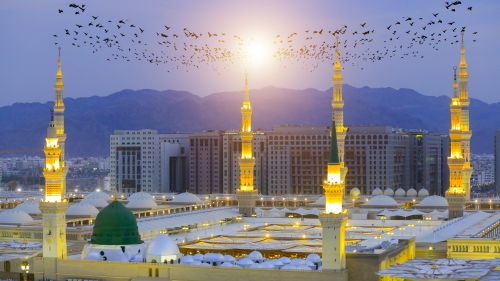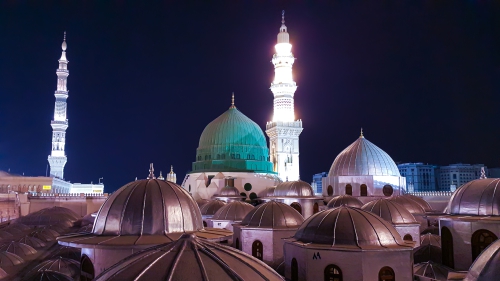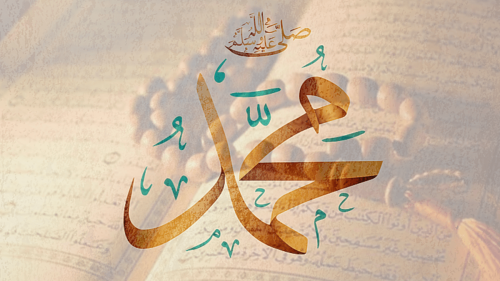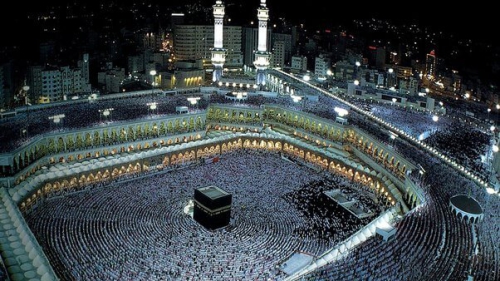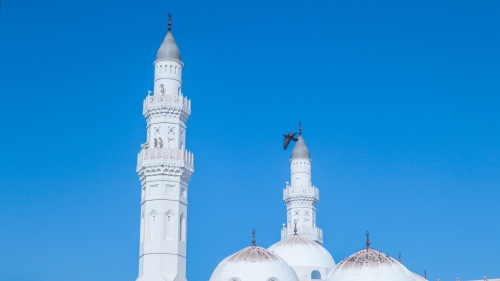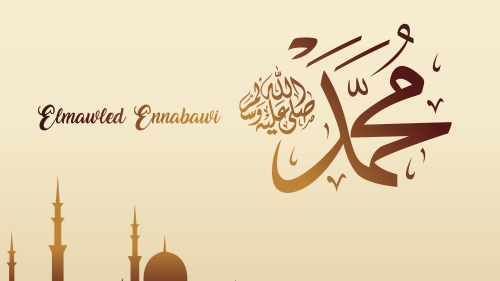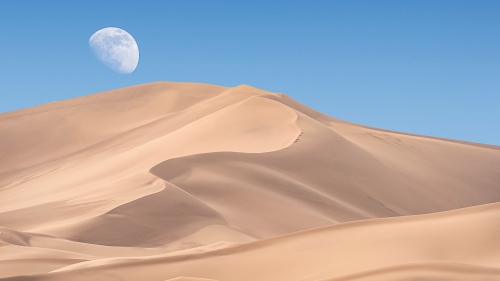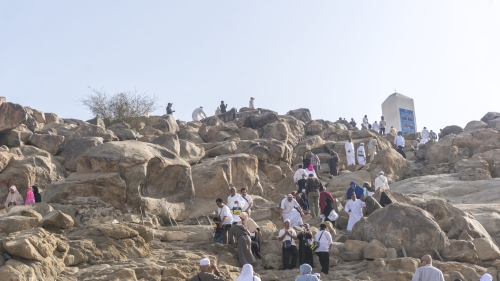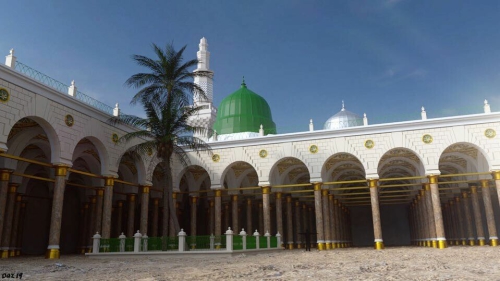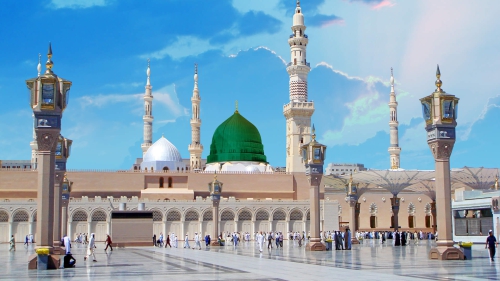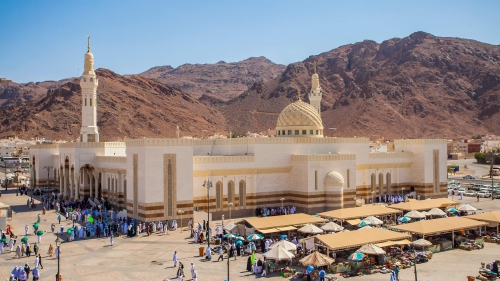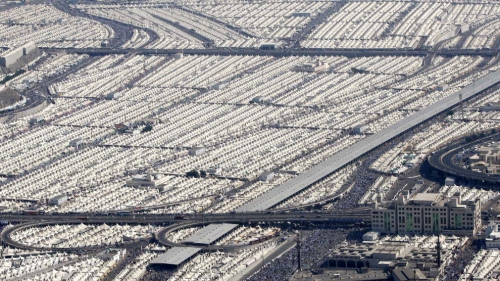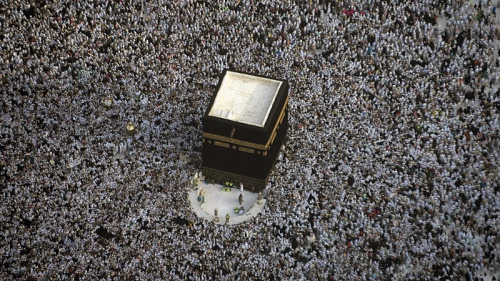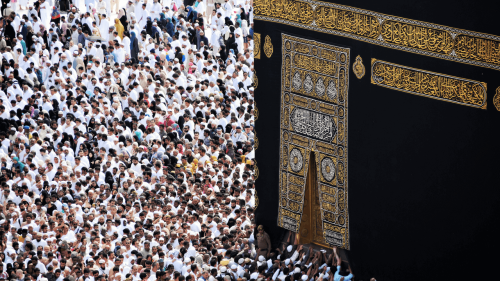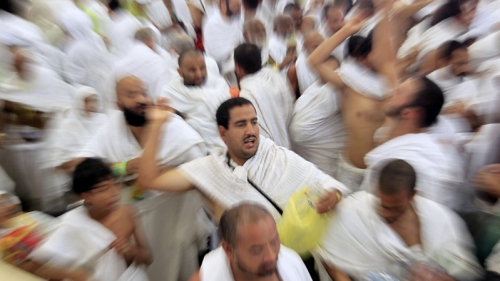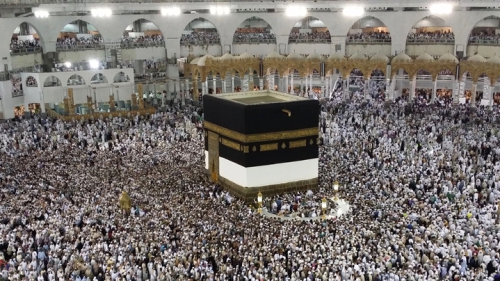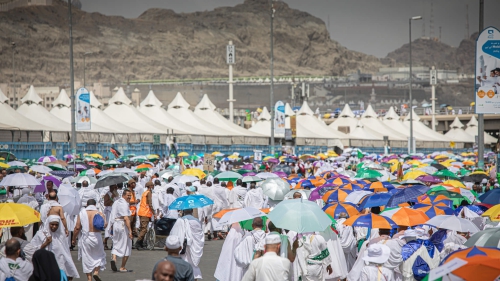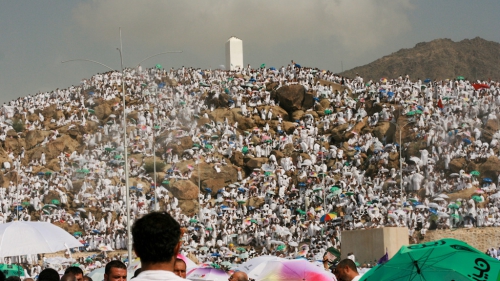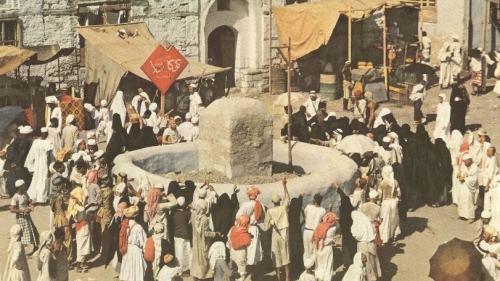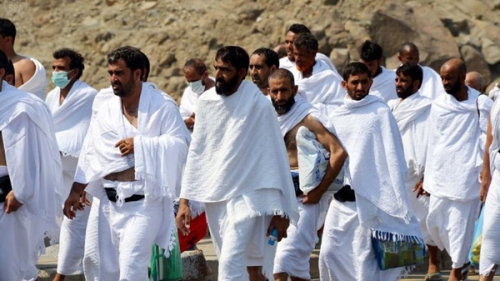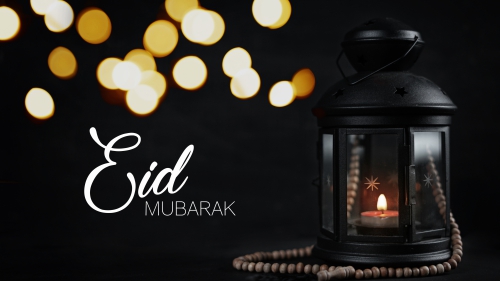The Spirituality of Hajj: Pilgrims’ Visit to Madinah

Visiting Madinah is not part of Hajj. However, since paying a visit to the Prophet’s mosque is a recommended act, all pilgrims use the Hajj opportunity to perform the latter as well. They do so either before Hajj or after it. Some pilgrims arrive in Makkah via Madinah, while others do not, but depart from Makkah to their homelands via it.
The distance between Makkah and Madinah is more than 400 km, which nevertheless accounts for nothing when compared with the distances most pilgrims cover to come for Hajj, and when compared with the benefits procured from visiting the Prophet’s mosque and its urban locus: the city of Madinah.
The Prophet said: “Journeys should not be made (to visit any mosque) except towards three mosques: the Sacred Mosque (al-Masjid al-Haram in Makkah), this mosque of mine (in Madinah) and the al-Aqsa mosque (in Jerusalem).” 1Abu Dawud, Sunan Abi Dawud, Book 11, Hadith No. 313.
The Prophet said about the virtues of praying in his mosque, thus inviting the faithful to undertake journeys from near and far to it: “One prayer in my mosque (in Madinah) is better than one thousand prayers elsewhere, except the Sacred Mosque (al-Masjid al-Haram in Makkah), and one prayer in the Sacred Mosque is better than one hundred thousand prayers elsewhere.” 2Ibn Majah, Sunan Ibn Majah, Book 5, Hadith No. 604.
Once in Madinah, a pilgrim is to visit the Prophet’s mosque and to pray in it before anything else. That should be the chief reason for his visit; all other things are supplementary and assume subsidiary roles. After that, a pilgrim is to visit the Prophet’s grave and the graves of his two closest companions: Abu Bakr and ‘Umar bin al-Khattab, which are integrated into the mosque proper, observing the highest standards of Islamic monotheism and its ethical codes.
A pilgrim then can go and visit al-Baqi’, the historic cemetery of Madinah containing the graves of many members of the first and best generations of Islam, because Muslims (albeit men more than women) are generally encouraged to visit graveyards in order to reflect upon the true meaning of life and death and to supplicate for the dead. A pilgrim can also visit the scene of the battle of Uhud, the second major battle between Muslims and polytheists in which the Prophet and his companions underwent unprecedented trials, in order to ruminate on jihad, sacrifice and martyrdom, and to pray for the many martyrs that fell in the battle.
Finally, a pilgrim is expected to visit the Quba’ mosque and pray there. It was the first mosque built by the Prophet, which is located about 4 km south of the Prophet’s mosque. Doing that constitutes a sunnah (tradition) of the Prophet who himself used to go to the mosque sometimes walking and sometimes riding. According to some reports, whenever he was free the Prophet used to visit the Quba’ mosque every Saturday, each time offering a voluntary prayer of two units (rak’ah). 3Al-Bukhari, Sahih al-Bukhari, Book 20, Hadith No. 5. A great reward is promised for following this sunnah, as the Prophet disclosed: “Whoever purifies himself in his house, then comes to the Quba’ mosque and offers a prayer therein, will have a reward like that for ‘Umrah (lesser pilgrimage).” 4Ibn Majah, Sunan Ibn Majah, Book 5, Hadith No. 610.
The spiritual legitimacy of visiting these places is obtained from a great many sayings and deeds of the Prophet and his companions. Making those visits, moreover, falls into the category of travelling through the land with the aim of enlivening and possessing “hearts by which to reason and ears by which to hear, for indeed, it is not eyes that are blinded, but blinded are the hearts which are within the breasts” (al-Hajj, 46).
There is certainly a reason why this verse of the Qur’an is mentioned in surah (chapter) al-Hajj or the Pilgrimage. In the surah, besides talking about the aspects of Hajj, the Qur’an in addition pores over a number of ancient failed civilizational legacies which paid no heed to the counsels of their holy prophets. People are advised thereby to traverse the land with the intention of discovering, learning about and appreciating the truth and its ways. The good is to be acknowledged and emulated, and the bad discredited and rejected.
The history of Prophet Muhammad’s mission and its everlasting legacy is to be viewed in a similar vein. During this last prophet-hood episode, too, there were many virtuous persons and groups, and there were also as many wicked ones. Each side lived up to its billing and, while meeting its end, contributed to the vibrant history-making systems. Without a doubt - in passing - history is such a wonderful and stimulating subject to study. It never stops giving, nor surprising. It signifies a school and an anthology of signs together with practical learning modules.
As to those historical places in Madinah which are connected with additional chapters and experiences of the Prophet’s mission, but which have been neither explicitly recommended to be visited, nor popularly frequented by the members of the early and best Muslim generations, they are also to be considered in accordance with the general principles of journeying through the earth and of expanding and enriching the living history syllabi.
Some of such places in Madinah are the mosque of the two qiblahs or directions (masjid al-qiblatayn), the location of the battle of khandaq (trench) during which the sheer survival of Islam and Islamic community was at stake, the mosque of jumu’ah commemorating the first jumu’ah (Friday) prayer in Madinah in particular and in Islam in general, and a number of gardens, wells, natural landmarks and mosques that memorialize certain persons, tribes and remarkable individual as well as collective events. It stands to reason that the same can be said about the rest of the residues of Islamic, but especially Ottoman-generated, civilization in Madinah.
However, inasmuch as the city of Madinah is a holy place and together with the city of Makkah the best and most spiritually-charged environment (scholars disagree inconclusively as to whether Makkah or Madinah is the best place on earth), one must make sure whenever visiting any segment of Madinah that his intention and goals are right and that there is nothing direct or indirect as could militate against the pure monotheistic predilections of Islam. For example, a pilgrim or any other visitor cannot regard a person, a place, or an event as sacrosanct and at times yet sacred, whereas in reality they are not, nor can he offer supplications and voluntary prayers in relation to the former, regarding those supplications and prayers superior as a result of one’s mistaken perspectives and misguided beliefs.
People are expected to come to Madinah to purify themselves, to advance their spirituality and to learn more about history. It would be tragic if owing to his personal irrepressible ignorance and unalterable misguidance a person not only does not attain any specific benefit worth mentioning, but also further undermine whatever is left of the purity of his Islam and his spiritual identity. A subtle balance needs to be struck between the holy aspects of Madinah and its mere historical, natural and socio-cultural aspects. No aspect from the former class is to be demoted in any way, just as no aspect from the latter class is to be put by any means on a religious pedestal.
Needless to say that for the successful creation and maintenance of this sense of balance, appropriate formal and informal educational strategies both locally and throughout the Muslim world, appropriate policies and their wise, plus adequate, implementation, and the origination of a profound religious consciousness and culture – are needed. Resorting to wisdom, fair exhortation and argumentation in ways that are best and most gracious, is the way to do it. Any form of extreme and rigid behaviour is destined not just to seriously flounder, but as well boomerang in the long run.
Madinah should be seen firstly as an open-air museum and secondly as a living and organic paradigm of the civilizational dimension of the Islamic message. The echoes of the Prophet’s and his immediate successors’ golden age of Islam can still be felt in the realms of thought and nostalgia, in the deepest conceptual and functional recesses of the Prophet’s mosque complex, and all over the veneers of the impressive topography of Madinah which has undergone little change in the course of time. The primary purpose of visiting Madinah is to develop a sixth sense and to be thus enabled to feel the reverberations of history and to realize as much the historical civilizational impact of Islam as its current potentials for achieving the same.
With such a realization on-board, a pilgrim’s next step would be to shift focus onto himself and to probe his very self as regards his knowledge and appreciation of Islamic history, and as regards his readiness to contribute whatever is viable within his powers for the sake of reviving Islamic cultural and civilizational fortunes. Regardless of the findings, a pilgrim should next embark on devising all the necessary plans and modi operandi for improving his lot.
Visits to Madinah ought to be spirited and effective, rather than passive and ineffective. A pilgrim cannot simply be there, nor intend to amuse himself or have a good time in the worldly sense of the term. Islam does not endorse the notions of tourism and leisure industry as found in contemporary materialistic cultures. If it does not overall, Islam’s position within the framework of the holy city of Madinah is then even more rigorous. As said before, the preponderant objective of Islamic travel (tourism) is an educational and spiritual refinement, so that the hearts and minds of people “may thus learn wisdom and their ears may thus learn to hear”.
Madinah likewise stands for a corpus of lessons and signs. No page of its history that is void, and no facet of its theoretical and physical presence that is barren. The city’s spiritual opulence is cornucopian. Historically, the city served as a microcosm of Islamic ummah and its winding civilizational course. Whatever happened to Muslims as a unified group reflected itself in some way onto the conditions of Madinah. Madinah was at once the source and aqueduct that supplied value to the rest of the Muslim world, ceaselessly irrigating and nourishing it. Madinah formed the core. If intrinsically Makkah was the umm al-qura, the mother of human cities and villages, historicity- and religiosity-wise, Madinah operationally has grown to be the fountainhead of all Muslim civilizational endeavours and, as such, the mother of the worth of fast-expanding Muslim civilizational axes. Hence, Makkah is described as mukarramah, which means “honoured” and “respected”, on the one hand, and the source of honour and reverence to people and other places on the other; while Madinah is called munawwarah, which means “illuminated”, “enlightened” and “splendid”, on the one hand, and the source of enlightenment, brilliance and splendour to the world on the other.
It is in this sense that Madinah is incomparable. It was the Muslim civilizational soul whose myriad features should continuously be studied and the findings methodically implemented, weaving them into the fabric of the current Muslim religious-cum-civilizational reawakening. Firstly Madinah was a city-state, then it became the capital of the rapidly growing cosmopolitan Islamic state. The situation did not change until the caliphate of the fourth rightly-guided Caliph, Ali bin Abi Talib, who moved the capital from Madinah to Kufah in Iraq approximately 35 years after the establishment of Madinah. Caliph Ali’s action notwithstanding, Madinah continued performing and giving, unofficially as well as popularly.
What Caliph Ali did was an act of political expediency, which, taking everything into consideration, backfired spectacularly. Following the move, and the events associated with it, neither Madinah nor the Muslim world was to be the same ever again. The Prophet hinted at all this miraculously when he said – or rather warned: “Yemen will be conquered and some people will migrate (from Madinah) and will urge their families and those who will obey them to migrate (to Yemen), although Madinah will be better for them, if they but knew. Syria will be conquered and some people will migrate (from Madinah) and will urge their families and those who will obey them to migrate (to Syria), although Madinah will be better for them, if they knew. Iraq will be conquered and some people will migrate (from Madinah) and will urge their families and those who will obey them to migrate (to Iraq), although Madinah will be better for them, if they knew.” 5Al-Bukhari, Sahih al-Bukhari, Book 29, Hadith No. 9.
Moreover, once a Bedouin came to the Prophet and gave a pledge of allegiance for embracing Islam. However, the next day he came with fever and asked for permission to cancel his pledge both of embracing Islam and of migrating to Madinah. The Prophet refused the request three times and said that Madinah is like a furnace; it expels out the impurities (bad persons) and selects the good ones and makes them perfect. 6Ibid., Book 29, Hadith No. 17.
In the beginning, due to the conditions which Islam and Muslims were living through in Makkah, performing the hijrah (migration to Madinah) was imposed as an individual duty, particularly after the successful formation of the Muslim community in Madinah had come to pass. Undertaking the hijrah was incumbent on each person because of the dangers Muslims were exposing themselves to in Makkah and elsewhere. Such dangers, some of which were life threatening, incapacitated the followers of Islam from living peacefully and practicing under normal circumstances their new religion. Additionally, the hijrah was an individual duty because the young community in Madinah was in dire need of abundant human resources with diversified capabilities and talents. The city-state of Madinah needed to evolve swiftly into a strong, thriving and respectable community capable of defending itself and its ideals.
However, in the wake of the conquest (fath or opening to Islam) of Makkah, in the eighth year after the hijrah, most of the Arabian Peninsula communities entered the fold of Islam. Those who declined to do so peacefully accepted the rule of Islam and Muslims. It was around this time that the Prophet proclaimed that there is no hijrah (migration) to Madinah after the take-over of Makkah; there remained only jihad and niyyah (intending good in all actions) afterwards. 7Al-Bukhari, Sahih al-Bukhari, Book 56, Hadith No. 282.
Henceforth, the Prophet used to encourage people to stay in their own milieus, and to contribute right there whatever they could for the implementation and dissemination of the Word of Allah, since “to Allah belongs all that is in the heavens and on earth…” (al-Baqarah, 284), and “to Allah belongs the east and the west. So wherever you (might) turn, there is the Face of Allah. Indeed, Allah is all-Encompassing and Knowing” (al-Baqarah, 115).
The Prophet closed the door of the hijrah to Madinah – but expanded the door of jihad and good work – for three reasons: to prevent undesired and uncontainable crowding in Madinah; to maintain the demographic balance of the city, or more precisely, to safeguard the identity, interests and roles of ansar (helpers or Madinah natives), for the number of migrants was set to increase, and the number of ansar decrease, evermore; and to encourage the establishment and growth of other Muslim settlements.
Today when a pilgrim visits Madinah he should keep in mind the city’s past hijrah (migration) dynamics. He should recognize that his being a Muslim and his pilgrimage undertaking are the results of the influences of those bygone kinetics. His case – just like the case of each and every other Muslim - still dwells right there in the supernatural spectrum, or continuum, dominated by myriads of contending forces and parties. The pilgrimage act is one of remembrance and return, and a pilgrim’s intense delight vis-à-vis essentially everything in Madinah is a tribute to a sort of homecoming.
A pilgrim returns to where it all began: to ground zero. He traces back where and how his spiritual distinctiveness originated, appreciating the mammoth efforts of the Madinah phenomenon and those of the plethora of remarkable personalities it created. Certainly, were it not for them, a pilgrim would not be what he is, and his vantage points from which he views the world today would be different.
This way, when visiting Madinah, a pilgrim returns to his spiritual roots and to his primordial self. He remembers who he actually is, and covenants to make certain that nothing will stand between him and his honourable life destiny. He understands that for him such is the best form of hijrah and jihad in the contemporary sense. It spells a progression (migration) towards, and struggle for, full dedication to righteousness and excellence through thoughts, words and deeds. It furthermore implies a pilgrim’s eternal improvements in his capacities as a Muslim, a servant of truth, and as a citizen of the world. About the state of dedication to and readiness for jihad (exertions to render the Word of God ultimate on earth) the Prophet said: “When you are called for jihad, you should immediately respond to the call.” 8Ibid., Book 56, Hadith No. 282.
Every Muslim owes much to Madinah. That connotes a burden that should weigh heavily with pilgrims and should come to the fore most during their visit to the Prophet’s grave. Coming to Madinah and visiting the grave of the Seal of Prophets represent the highlight on every pilgrim’s list. To many, the whole excitement of the Madinah visit boils down to the moment of visiting the Prophet’s grave and greeting him directly and addressing him personally. All other considerations and excitements are tributary and contingent on the former.
However, looking from an alternative perspective, visiting the Prophet’s grave ought not to be oversimplified, just as it ought not to be hyperbolized nor overwrought unorthodoxly. Visiting the grave should not be like a walk in the park, or like a part of an excursion, imbued with a personalized spiritual ecstasy. Instead, it should be placed somewhere in-between as a crowning meeting and as a moment of truth. It can even be perceived as a showdown, so to speak, albeit with one’s own self and one’s own behavioural disposition in the vicinity of the Prophet. The visit is not to be held as a recreation, but a burden, nor as a finale, but an intermission that calls for an action program.
Visiting the Prophet’s grave should amount to a way of self-questioning and examination of consciousness. A pilgrim is to follow the code of ethics designated for the purpose, and as part of that very code, while addressing the Prophet, a pilgrim is instructed to affirm in a dignified manner, after invoking peace and blessings on the Prophet and his family: “I bear witness that you are indeed the Messenger of Allah, that you conveyed the message and fulfilled the trust, and advised the ummah and strove truly for the sake of Allah. May Allah reward you on behalf of your ummah better than any Prophet is rewarded on behalf of his nation.” 9Visiting the Prophet’s Mosque
This is the most solemn testimony. In it, while reading between the lines, a pilgrim should get the message relating to himself, his family and his community. Yet, he should comprehend the circumstances of the whole world, given that the Prophet was sent to all mankind and as a mercy to all worlds. Declaring all this directly in front of the Prophet entails some serious questions as to what every individual has done and plans to do in the future in order to preserve and further advance the glorious legacy of the Prophet.
It is right there, furthermore, that a pilgrim should testify either for or against his self, pledging imminent amendments and improvements, before the day comes when the Prophet will do exactly the same: “…that you be witnesses over mankind and the Messenger be a witness over you” (al-Baqarah, 143). In the process of visiting the Prophet’s grave, avalanches of emotions, usually accompanied with shedding tears, are not the only benchmark.
At any rate, the Prophet’s mosque complex is and will forever be the main focus of attention with pilgrims. The mosque’s history and religious significance are one thing, but its size and architectural magnitude today are the other. Against the background of the former, the allure of the latter should not be underestimated. With its surrounding open spaces the mosque is so huge nowadays that it encompasses the entire range of the original Madinah city as it was during the time of the Prophet and the time of his immediate successors. The mosque incorporated the most historic area of Madinah and blended it in harmoniously – including the Prophet’s houses and particularly the house that features the Prophet’s grave and the graves of Abu Bakr and ‘Umar bin al-Khattab – rendering itself a living repository of the deepest meaning and greatest riches of Muslim history.
In terms of architecture, the mosque is exceptional. Hence, it invites and deserves attention. No pilgrim can stay aloof from the architectural display.
At first, the mosque was planned and built by the Prophet himself as soon as he and his companions had performed the hijrah from Makkah. Since its inception, the mosque was meant to be a catalyst for fostering, and at the same time refining, a Muslim civilizational consciousness and yield. It was not by chance, therefore, that the mosque was positioned most strategically and right in the middle of the city of Madinah, the prototype Islamic city, and was made to function as a community development centre with basically all religious, social, educational and political functions operating within its sphere.
The story of the phenomenon of the Prophet’s mosque throughout history - as a concept, architectural reality, and religious as well as socio-political mother institution - is a story of the evolution of Muslim society from an austere and local cultural setup to a global level of civilizational sophistication and dominance. Its story is also about the development of a vocabulary of mosque architecture from mud bricks, plain walls, earth plaster, joists and branches of date palms, to marble, intricate decorative styles, domes, arches, elegant carpets, reinforced concrete, brass, air conditioning and escalators. It was a journey from a structural and artistic minimalism to a total architectural elegance and refinement, so as to strengthen, facilitate, foster and further promote the noble status and utility of the Prophet’s mosque and the performance of Muslim society all together.
Despite the dramatic artistic and architectural changes that were affecting the mosque’s configuration and form, the purpose and function of the mosque remained unchanged. In fact, as a result of the fast-changing regional and international contexts, such a disposition of the mosque was only meant to be aided and its fulfillment accelerated and additionally promulgated by means of the former. The architecture of the mosque was in service of the latter’s religious and civilizational mission.
The history and architecture of the Prophet’s mosque can furnish the Muslim mind and Muslim scholarship with invaluable lessons in connection with such vital subjects as the causes of the evolution of the discernable identity of Muslim civilization and architecture; the relationship between architecture, society and civilization in Islam; institutional ideological harmony as opposed to institutional ideological dichotomy; the meaning of architectural pragmatism, creativity and democracy; the relationship between tradition and modernity; the evolution of Muslim architecture and civilization between the forces of conformity and deviation; and the relationship between architecture and politics.
These are the universal and perennial issues that Muslim architecture grapples with in every time and place, providing varied answers and solutions because of the varied impacts generated by different contributive factors. The same happened to Muslim architecture in the context of the development of the Prophet’s mosque during the long and colorful history of Islam and Muslim peoples. What many individuals from the first till the recent modern Saudi expansions of the mosque have done signifies their conscious and unconscious civilizational behavioral standards, with the standards being the cause and the architectural outputs the effect.
The concept behind the latest Prophet’s mosque design was to achieve a harmonious integration between the existing historical areas and elements of the mosque - dating back to the Mamluks, Ottomans and the first Saudi expansion - and the new technologically advanced expansion, resulting in a balanced and organic entity. The protrusion of the oldest (commonly called Ottoman) part of the mosque from the building’s main rectangle frame in the southern qiblah sector signalled that the old architectural traditions of the mosque - along with the principles and values such traditions exemplified - denoted the basis of the building’s architectural legitimacy, and a point of reference for evaluating its overall operations and prospective future directions.
Therefore, to some, like Abd al-Basit Badr, 10Abd al-Basit Badr, Al-Tarikh al-Shamil li al-Madinah al-Munawwarah, (Madinah: npp, 1996), vol. 3 p. 269. the plan of the mosque after the second and biggest Saudi expansion resembles somewhat a wide human upper body with broad shoulders. The protruding oldest part of the mosque brings to mind the idea of the head and its neck, and the rest of the mosque reminds of the body. The message that the allegory conveys is unmistaken insofar as the relationship between the old and new sections of the mosque are concerned. As the receptacle of values, the former inspired and guided, whereas the latter as the receptacle of contemporary challenges and their solutions, was directed and propelled.
The latest modern expansion of the mosque was to concentrate on the mixture of the classical Muslim architectural traditions, while at the same time accentuating the use of suitable building materials that distinguish the historical, alongside geographical, landscape of Saudi Arabia, such as granite, marble and stone. 11Muhammad Isma’il, The Architecture of the Prophet’s Holy Mosque, (London: Hazar, 1998), p. 87. The intention, additionally, was to apply the latest advances in building technology and engineering through high-tech building designs, industrialized construction materials, production, as well as building methods and techniques. The pure vernacular styles of architecture in the Arabian Peninsula, employing mainly mud bricks, timber, earth plaster and stone rubble, were shunned firstly because, when it comes to durability, strength and visual appeal, they were inadequate for the sophisticated and ultramodern expansion, and secondly because they were essentially local in character and so, were not in a position to create a globally recognized and accepted brand of Muslim architecture.
These philosophical considerations and practical criteria turned the Prophet’s mosque into arguably the most beautiful building in the Muslim world and into the best representation of Islamic architecture today. The mosque became a source of pride to Muslims. Following the ultramodern Saudi expansions, the mosque became the largest continuously roofed building in the world with the capacity to accommodate in excess of one million worshippers. 12Naji Muhammad al-Ansari, ‘Imarah wa Tawsi’ah al-Masjid al-Nabawi al-Sharif ‘Abr al-Tarikh, (Madinah: Nadi al-Madinah al-Munawwarah al-‘Adabi, 1996), p. 206. The mosque is often regarded as “the realization of one of the most unique architectural feats in the world.” 13Muhammad Isma’il, The Architecture of the Prophet’s Holy Mosque, p. 314.
The strongest evidence for all this is that most pilgrims – and other mosque users in general – have always had nothing but admiration and praise for the mosque’s architectural and artistic distinctiveness. No significant criticism whatsoever could be heard, formally or informally. People simply identify their spiritual and psychological proclivities with those of the mosque. They then live through the experience – that is, they feel and “live” the mosque and the world of its ideals – and return to their homelands with the undeletable impressions of exultation and delight.
Given that these items are as much spiritual and emotional as they are intellectual, even the most ordinary pilgrims can “understand” and experience them sufficiently. It does not take a world to enable a person to have what it takes to do so. It is only that his genuine Islam-ness, humaneness and pure essence should be kept alive and unblemished. Definitely, it would be a serious loss if pilgrims come to Madinah unprepared to supplement their Hajj experiences with the boons the Prophet’s mosque has in store for them.
A series of articles adapted from the latest book by Dr. Spahic Omer, "The Spirituality of Hajj".
Footnotes
Topics: Hajj, Madinah (Medina) Values: Spirituality Channel: Hajj - Day 5
Views: 5087
Related Suggestions







